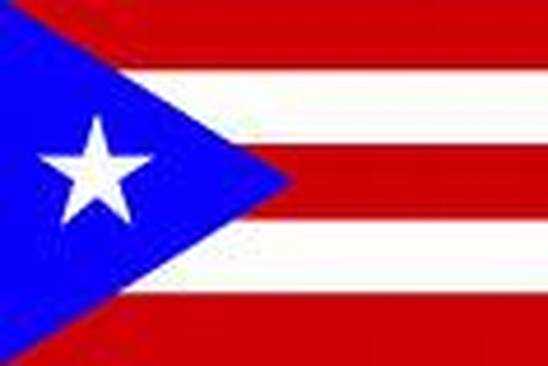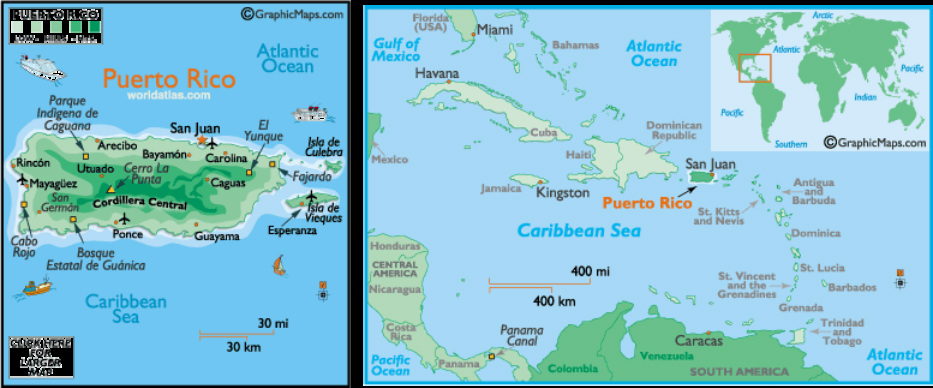History

Island Details
After Christopher Columbus arrived in 1493, the island was colonized in 1508, and the capital city of San Juan founded in 1521.
As a result of the Spanish-American War, Puerto Rico was relinquished to the USA by Spain in 1898. Today it is a self governing (very independent-minded) territory of the USA, and enjoys much autonomy.
The narrow coastal plain rises into green (low) hills and mountains central and south. A few small rivers and lakes dot the landscape.
The climate is usually hot and humid, with some lower temperatures found in the higher elevations. Like most Caribbean islands, Puerto Rico is subject to an occasional hurricane warning (May - October).
The island is a mecca for Caribbean cruise ships and tourists from around the world. Old San Juan is the most popular destination.
Compared to other islands in the Caribbean, Puerto Rico has a high standard of living with a vibrant industrialized economy.
Quick Facts and Figures
Official Name Puerto Rico, Commonwealth territory
of the USA, claimed 1898
Population 3,949,000 (July 2003 est.)
Capital City San Juan (434,000)
Languages Spanish, English
Official Currency US Dollar
Religions Catholic, Protestant
Land Area 9,100 sq km
Latitude/Longitude 18º 15N, 66º 30W
Highest Point Cerro del Punta at 4,389 ft. (1,338m)
After Christopher Columbus arrived in 1493, the island was colonized in 1508, and the capital city of San Juan founded in 1521.
As a result of the Spanish-American War, Puerto Rico was relinquished to the USA by Spain in 1898. Today it is a self governing (very independent-minded) territory of the USA, and enjoys much autonomy.
The narrow coastal plain rises into green (low) hills and mountains central and south. A few small rivers and lakes dot the landscape.
The climate is usually hot and humid, with some lower temperatures found in the higher elevations. Like most Caribbean islands, Puerto Rico is subject to an occasional hurricane warning (May - October).
The island is a mecca for Caribbean cruise ships and tourists from around the world. Old San Juan is the most popular destination.
Compared to other islands in the Caribbean, Puerto Rico has a high standard of living with a vibrant industrialized economy.
Quick Facts and Figures
Official Name Puerto Rico, Commonwealth territory
of the USA, claimed 1898
Population 3,949,000 (July 2003 est.)
Capital City San Juan (434,000)
Languages Spanish, English
Official Currency US Dollar
Religions Catholic, Protestant
Land Area 9,100 sq km
Latitude/Longitude 18º 15N, 66º 30W
Highest Point Cerro del Punta at 4,389 ft. (1,338m)

Interesting Facts
Puerto Rico is close to the deepest submarine depression in the North Atlantic Ocean. The Puerto Rico Trench, roughly parallel to the northern coast of the island of Puerto Rico and lying about 75 miles (120 km) to the north. The Puerto Rico Trench is about 1,090 miles (1,750 km) long and 60 miles (100 km) wide. The deepest point in the Atlantic Ocean, the Milwaukee Depth, lies within the Puerto Rico Trench, at a depth of 27,493 feet (8,380 meters) in the western end of the trench, about 100 miles (160 km) northwest of Puerto Rico. The origin of the trench can be traced back to the beginning of the Tertiary period. The Puerto Rico Trench appears to be part of a complex system of sinistral strike-slip faults in the north Caribbean; the trench seems to have been opened continuously for about 70 million years. It is partially filled with sediments. The Caribbean's greatest known depth is Cayman Trench (Bartlett Deep) between Cuba and Jamaica, at approximately 25,216 feet (7,686 meters) below sea level.
A municipality (municipio) is an administrative local area generally composed of a clearly defined territory and commonly referring to a city, town, or village government. In Puerto Rico, a municipality is a city and the government unit that is the primary legal subdivision; each municipality has an elected mayor. However, the Census Bureau treats the municipio as the statistical equivalent of a county.
Mona and Monito Islands are located between Puerto Rico and the Dominican Republic. These small islands are considered the Galápagos Islands of the Caribbean Sea. No other reef and offshore island habitat within U.S. jurisdiction possesses such ecological uniqueness, invaluable habitat, and biological diversity within such a reduced surface area. For these reasons, Mona and Monito Islands have been recognized by the Commonwealth of Puerto Rico as a Natural Reserve. The islands are a critical habitat of endangered marine turtles, sea birds and occasional migratory marine mammals.
Spanish or Castilian (español or castellano) is, like French, Portuguese, Italian, an Iberian Romance language, derived from Latin. Spanish is a phonetic language, words are pronounced exactly as they are spelled.
According to Ethnologue Spanish is the second language in the world, after Mandarin Chinese and ahead of English. Spanish is spoken by more than 400 million people worldwide, primarily in Spain and Latin America. Spanish is the official language in 24 countries, with over 323 million native speakers, Puerto Rico accounts for less than 4 million (figure from the 15th Edition of the Ethnologue). With such large geographic expanse the Spanish language has developed many local variations or dialects.
These variations are the result of different regions and countries integration of their local history and culture - creating differences in concepts, usage, idioms and vocabulary; and distinct accents.
Puerto Rico has developed a unique version of Spanish. The language was greatly influenced by Puerto Rico's history. Puerto Ricans integrated thousands of Taíno words, adopted some pronunciation habits from African dialects, and incorporated English words or phrases (known as "Spanglish") into the language.
Puerto Ricans can understand Spanish speakers from other countries, while there may be some differences, such differences are not excessive and does not obstruct communication.
Language has been a central issue in Puerto Rican education and culture since 1898. Until 1930 U.S. authorities insisted upon making English the language of instruction in the schools, the intent being to produce English-speaking persons of American culture in the same way this is done in the United States public schools. But strong resistance to the policy finally brought a change to the use of Spanish as the basic school language, English becoming a second language studied by all. In 1991 the Puerto Rican legislature, following the lead of the pro-commonwealth Popular Democratic Party and the governor, Rafael Hernández Colon, endorsed a bill that made Spanish the island's official language, thus reversing a 1902 law that gave both Spanish and English official recognition. In 1993 the pro-statehood governor, Pedro J. Rossello, signed legislation restoring equal status to Spanish and English.
When Puerto Ricans want to express their nationality, they say: Soy de aquí como el coquí (I'm as Puerto Rican as a coquí).
Puerto Rico is close to the deepest submarine depression in the North Atlantic Ocean. The Puerto Rico Trench, roughly parallel to the northern coast of the island of Puerto Rico and lying about 75 miles (120 km) to the north. The Puerto Rico Trench is about 1,090 miles (1,750 km) long and 60 miles (100 km) wide. The deepest point in the Atlantic Ocean, the Milwaukee Depth, lies within the Puerto Rico Trench, at a depth of 27,493 feet (8,380 meters) in the western end of the trench, about 100 miles (160 km) northwest of Puerto Rico. The origin of the trench can be traced back to the beginning of the Tertiary period. The Puerto Rico Trench appears to be part of a complex system of sinistral strike-slip faults in the north Caribbean; the trench seems to have been opened continuously for about 70 million years. It is partially filled with sediments. The Caribbean's greatest known depth is Cayman Trench (Bartlett Deep) between Cuba and Jamaica, at approximately 25,216 feet (7,686 meters) below sea level.
A municipality (municipio) is an administrative local area generally composed of a clearly defined territory and commonly referring to a city, town, or village government. In Puerto Rico, a municipality is a city and the government unit that is the primary legal subdivision; each municipality has an elected mayor. However, the Census Bureau treats the municipio as the statistical equivalent of a county.
Mona and Monito Islands are located between Puerto Rico and the Dominican Republic. These small islands are considered the Galápagos Islands of the Caribbean Sea. No other reef and offshore island habitat within U.S. jurisdiction possesses such ecological uniqueness, invaluable habitat, and biological diversity within such a reduced surface area. For these reasons, Mona and Monito Islands have been recognized by the Commonwealth of Puerto Rico as a Natural Reserve. The islands are a critical habitat of endangered marine turtles, sea birds and occasional migratory marine mammals.
Spanish or Castilian (español or castellano) is, like French, Portuguese, Italian, an Iberian Romance language, derived from Latin. Spanish is a phonetic language, words are pronounced exactly as they are spelled.
According to Ethnologue Spanish is the second language in the world, after Mandarin Chinese and ahead of English. Spanish is spoken by more than 400 million people worldwide, primarily in Spain and Latin America. Spanish is the official language in 24 countries, with over 323 million native speakers, Puerto Rico accounts for less than 4 million (figure from the 15th Edition of the Ethnologue). With such large geographic expanse the Spanish language has developed many local variations or dialects.
These variations are the result of different regions and countries integration of their local history and culture - creating differences in concepts, usage, idioms and vocabulary; and distinct accents.
Puerto Rico has developed a unique version of Spanish. The language was greatly influenced by Puerto Rico's history. Puerto Ricans integrated thousands of Taíno words, adopted some pronunciation habits from African dialects, and incorporated English words or phrases (known as "Spanglish") into the language.
Puerto Ricans can understand Spanish speakers from other countries, while there may be some differences, such differences are not excessive and does not obstruct communication.
Language has been a central issue in Puerto Rican education and culture since 1898. Until 1930 U.S. authorities insisted upon making English the language of instruction in the schools, the intent being to produce English-speaking persons of American culture in the same way this is done in the United States public schools. But strong resistance to the policy finally brought a change to the use of Spanish as the basic school language, English becoming a second language studied by all. In 1991 the Puerto Rican legislature, following the lead of the pro-commonwealth Popular Democratic Party and the governor, Rafael Hernández Colon, endorsed a bill that made Spanish the island's official language, thus reversing a 1902 law that gave both Spanish and English official recognition. In 1993 the pro-statehood governor, Pedro J. Rossello, signed legislation restoring equal status to Spanish and English.
When Puerto Ricans want to express their nationality, they say: Soy de aquí como el coquí (I'm as Puerto Rican as a coquí).